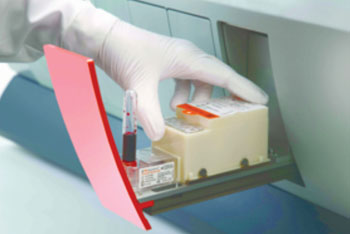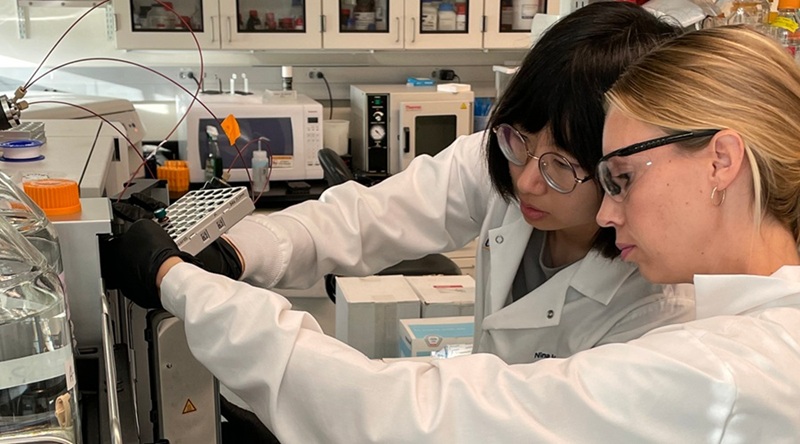Miniaturized Magnetic Resonance for Direct Diagnosis of Candida Infection in the Blood
|
By LabMedica International staff writers Posted on 30 Sep 2015 |

Image: Loading the T2Candida panel into the Stat drawer of the T2Dx instrument (Photo courtesy of T2 Biosystems).
An innovative approach for diagnosis of Candida infection directly from blood samples is based on miniaturized magnetic resonance technology and does not require any sample pretreatment or extraction.
T2 Biosystems, Inc. (Lexington, MA, USA) introduced its T2Candida Panel designed for use on the T2 Magnetic Resonance (T2MR) platform, the T2Dx, at the recent San Diego (CA, USA) joint meeting of the Interscience Conference on Antimicrobial Agents and Chemotherapy (ICAAC) and the International Society of Chemotherapy (ICC).
T2MR utilizes miniaturized magnetic resonance technology, which measures how water molecules react in the presence of magnetic fields. For molecular and immunodiagnostics targets it capitalizes on advances in the field of nanotechnology by deploying particles with superparamagnetic properties that enhance the magnetic resonance signals of specific binding events. When particles coated with target-specific binding agents are added to a sample containing the target, the particles bind to and cluster around the target. This clustering changes the microscopic environment of water molecules in that sample, which in turn alters the magnetic resonance signal, or the T2 relaxation signal that is measured, indicating the presence, absence, or concentration of the target.
Unlike most detection methods, T2MR can quickly and accurately identify molecular targets within patient samples without the need for purification or extraction of target molecules from the sample.
In a clinical study, specimens were collected from 23 patients on the day of enrollment and on days three, five and seven. Blood culture and T2Candida test results were compared to determine which method was most accurate for monitoring those patients.
Results revealed that T2Candida demonstrated greater accuracy in detecting invasive candidiasis, or the presence of the Candida infection, reporting 17 positive results during the testing period for nine patients with candidemia who were receiving antifungal therapy, while blood culture reported only three positive results within the same patient set. Overall, T2Candida demonstrated 91.1% sensitivity, 99.4% specificity, and limit of detection as low as one CFU/mL (colony forming unit per milliliter).
“Previous studies have demonstrated that blood culture may yield false negative test results when patients are on antifungal therapy,” said John McDonough, president and CEO of T2 Biosystems. “The results from this study demonstrate that T2Candida can provide more accurate results for patients who are on antifungals which can enable physicians to make better treatment decisions regarding the duration of therapy and controlling the source of the infection, including catheterization procedures and other medical interventions known to cause the disease.”
Details of the comparing the effectiveness of the T2Candida panel to blood culture were published in the September 15, 2015, online edition of the journal Future Microbiology.
Related Links:
T2 Biosystems, Inc.
T2 Biosystems, Inc. (Lexington, MA, USA) introduced its T2Candida Panel designed for use on the T2 Magnetic Resonance (T2MR) platform, the T2Dx, at the recent San Diego (CA, USA) joint meeting of the Interscience Conference on Antimicrobial Agents and Chemotherapy (ICAAC) and the International Society of Chemotherapy (ICC).
T2MR utilizes miniaturized magnetic resonance technology, which measures how water molecules react in the presence of magnetic fields. For molecular and immunodiagnostics targets it capitalizes on advances in the field of nanotechnology by deploying particles with superparamagnetic properties that enhance the magnetic resonance signals of specific binding events. When particles coated with target-specific binding agents are added to a sample containing the target, the particles bind to and cluster around the target. This clustering changes the microscopic environment of water molecules in that sample, which in turn alters the magnetic resonance signal, or the T2 relaxation signal that is measured, indicating the presence, absence, or concentration of the target.
Unlike most detection methods, T2MR can quickly and accurately identify molecular targets within patient samples without the need for purification or extraction of target molecules from the sample.
In a clinical study, specimens were collected from 23 patients on the day of enrollment and on days three, five and seven. Blood culture and T2Candida test results were compared to determine which method was most accurate for monitoring those patients.
Results revealed that T2Candida demonstrated greater accuracy in detecting invasive candidiasis, or the presence of the Candida infection, reporting 17 positive results during the testing period for nine patients with candidemia who were receiving antifungal therapy, while blood culture reported only three positive results within the same patient set. Overall, T2Candida demonstrated 91.1% sensitivity, 99.4% specificity, and limit of detection as low as one CFU/mL (colony forming unit per milliliter).
“Previous studies have demonstrated that blood culture may yield false negative test results when patients are on antifungal therapy,” said John McDonough, president and CEO of T2 Biosystems. “The results from this study demonstrate that T2Candida can provide more accurate results for patients who are on antifungals which can enable physicians to make better treatment decisions regarding the duration of therapy and controlling the source of the infection, including catheterization procedures and other medical interventions known to cause the disease.”
Details of the comparing the effectiveness of the T2Candida panel to blood culture were published in the September 15, 2015, online edition of the journal Future Microbiology.
Related Links:
T2 Biosystems, Inc.
Latest Microbiology News
- Blood-Based Diagnostic Method Could Identify Pediatric LRTIs
- Rapid Diagnostic Test Matches Gold Standard for Sepsis Detection
- Rapid POC Tuberculosis Test Provides Results Within 15 Minutes
- Rapid Assay Identifies Bloodstream Infection Pathogens Directly from Patient Samples
- Blood-Based Molecular Signatures to Enable Rapid EPTB Diagnosis
- 15-Minute Blood Test Diagnoses Life-Threatening Infections in Children
- High-Throughput Enteric Panels Detect Multiple GI Bacterial Infections from Single Stool Swab Sample
- Fast Noninvasive Bedside Test Uses Sugar Fingerprint to Detect Fungal Infections
- Rapid Sepsis Diagnostic Device to Enable Personalized Critical Care for ICU Patients
- Microfluidic Platform Assesses Neutrophil Function in Sepsis Patients
- New Diagnostic Method Confirms Sepsis Infections Earlier
- New Markers Could Predict Risk of Severe Chlamydia Infection
- Portable Spectroscopy Rapidly and Noninvasively Detects Bacterial Species in Vaginal Fluid
- CRISPR-Based Saliva Test Detects Tuberculosis Directly from Sputum
- Urine-Based Assay Diagnoses Common Lung Infection in Immunocompromised People
- Saliva Test Detects Implant-Related Microbial Risks
Channels
Clinical Chemistry
view channel
Online Tool Detects Drug Exposure Directly from Patient Samples
Doctors often rely on patient interviews and medical records to determine what medications a person has taken, but this information is frequently incomplete. People may forget drugs they used, take over-the-counter... Read more
Chemical Imaging Probe Could Track and Treat Prostate Cancer
Prostate cancer remains a leading cause of illness and death among men, with many patients eventually developing resistance to standard hormone-blocking therapies. These drugs often lose effectiveness... Read moreMolecular Diagnostics
view channel
New 15-Minute Hepatitis C Test Paves Way for Same-Day Treatment
Chronic hepatitis C infection affects an estimated 50 million people worldwide and causes around 242,000 deaths each year, largely due to cirrhosis and liver cancer. Although the infection is curable with... Read more
Ovarian Cancer Assay Outperforms Traditional Tests in Early Disease Detection
Globally, ovarian cancer is one of the deadliest cancers affecting women. Traditionally, early diagnosis of ovarian cancer has been challenging. Many ovarian cancers are diagnosed only after they have... Read moreHematology
view channel
MRD Tests Could Predict Survival in Leukemia Patients
Acute myeloid leukemia is an aggressive blood cancer that disrupts normal blood cell production and often relapses even after intensive treatment. Clinicians currently lack early, reliable markers to predict... Read more
Platelet Activity Blood Test in Middle Age Could Identify Early Alzheimer’s Risk
Early detection of Alzheimer’s disease remains one of the biggest unmet needs in neurology, particularly because the biological changes underlying the disorder begin decades before memory symptoms appear.... Read more
Microvesicles Measurement Could Detect Vascular Injury in Sickle Cell Disease Patients
Assessing disease severity in sickle cell disease (SCD) remains challenging, especially when trying to predict hemolysis, vascular injury, and risk of complications such as vaso-occlusive crises.... Read more
ADLM’s New Coagulation Testing Guidance to Improve Care for Patients on Blood Thinners
Direct oral anticoagulants (DOACs) are one of the most common types of blood thinners. Patients take them to prevent a host of complications that could arise from blood clotting, including stroke, deep... Read moreImmunology
view channel
Routine Blood Test Can Predict Who Benefits Most from CAR T-Cell Therapy
CAR T-cell therapy has transformed treatment for patients with relapsed or treatment-resistant non-Hodgkin lymphoma, but many patients eventually relapse despite an initial response. Clinicians currently... Read more
New Test Distinguishes Vaccine-Induced False Positives from Active HIV Infection
Since HIV was identified in 1983, more than 91 million people have contracted the virus, and over 44 million have died from related causes. Today, nearly 40 million individuals worldwide live with HIV-1,... Read more
Gene Signature Test Predicts Response to Key Breast Cancer Treatment
DK4/6 inhibitors paired with hormone therapy have become a cornerstone treatment for advanced HR+/HER2– breast cancer, slowing tumor growth by blocking key proteins that drive cell division.... Read more
Chip Captures Cancer Cells from Blood to Help Select Right Breast Cancer Treatment
Ductal carcinoma in situ (DCIS) accounts for about a quarter of all breast cancer cases and generally carries a good prognosis. This non-invasive form of the disease may or may not become life-threatening.... Read morePathology
view channel
Rapid Low-Cost Tests Can Prevent Child Deaths from Contaminated Medicinal Syrups
Medicinal syrups contaminated with toxic chemicals have caused the deaths of hundreds of children worldwide, exposing a critical gap in how these products are tested before reaching patients.... Read more
Tumor Signals in Saliva and Blood Enable Non-Invasive Monitoring of Head and Neck Cancer
Head and neck cancers are among the most aggressive malignancies worldwide, with nearly 900,000 new cases diagnosed each year. Monitoring these cancers for recurrence or relapse typically relies on tissue... Read more
Common Health Issues Can Influence New Blood Tests for Alzheimer’s Disease
Blood-based tests for Alzheimer’s disease are transforming diagnosis by offering a simpler alternative to spinal taps and brain imaging. However, many people evaluated at memory clinics also live with... Read more
Blood Test Formula Identifies Chronic Liver Disease Patients with Higher Cancer Risk
Chronic liver disease affects millions worldwide and can progress silently to hepatocellular carcinoma (HCC), one of the deadliest cancers globally. While surveillance guidelines exist for patients with... Read moreTechnology
view channel
Machine Learning Models Diagnose ALS Earlier Through Blood Biomarkers
Amyotrophic lateral sclerosis (ALS) is a rapidly progressive neurodegenerative disease that is notoriously difficult to diagnose in its early stages. Early symptoms often overlap with other neurological... Read more
Artificial Intelligence Model Could Accelerate Rare Disease Diagnosis
Identifying which genetic variants actually cause disease remains one of the biggest challenges in genomic medicine. Each person carries tens of thousands of DNA changes, yet only a few meaningfully alter... Read moreIndustry
view channel
Abbott Acquires Cancer-Screening Company Exact Sciences
Abbott (Abbott Park, IL, USA) has entered into a definitive agreement to acquire Exact Sciences (Madison, WI, USA), enabling it to enter and lead in fast-growing cancer diagnostics segments.... Read more



















